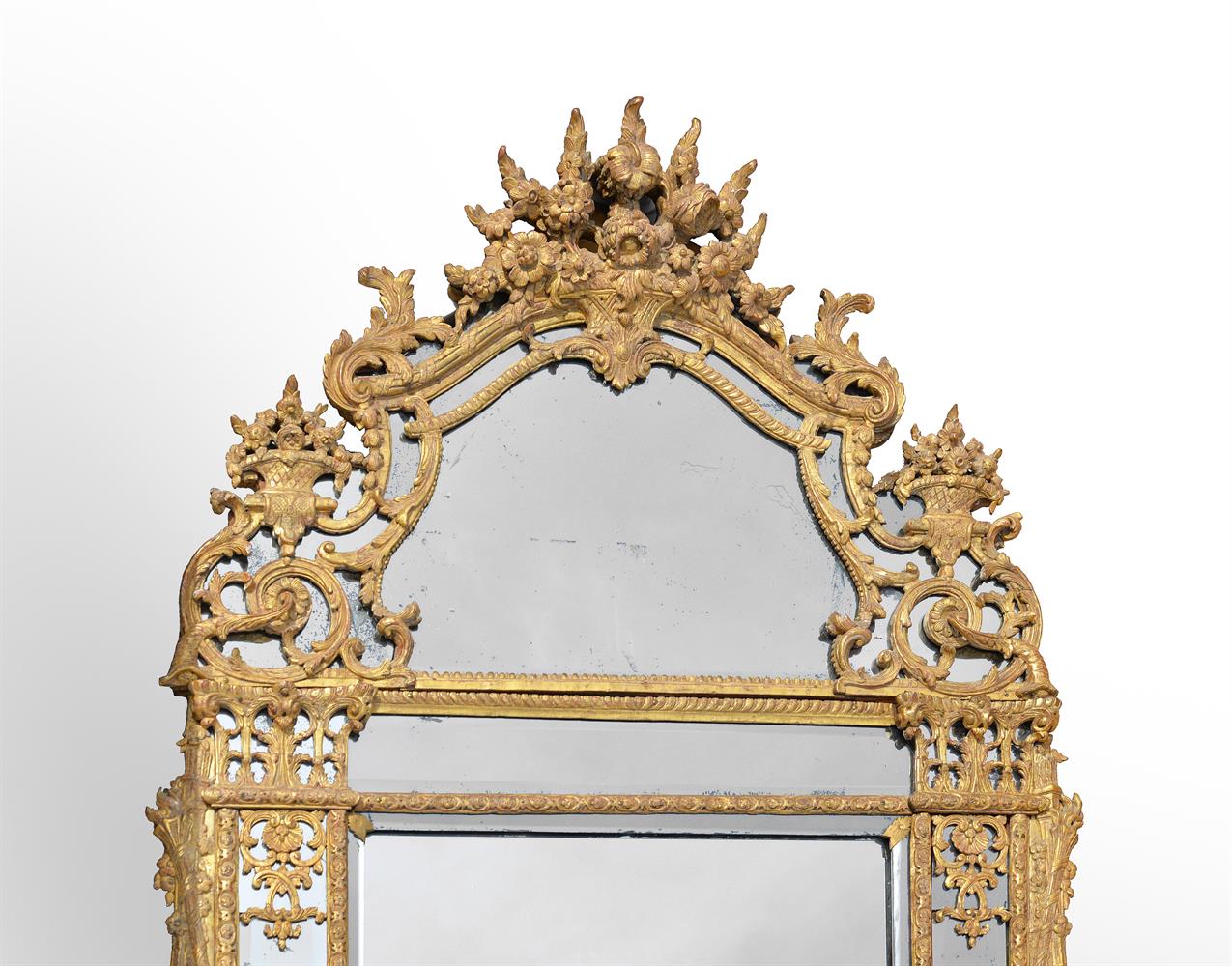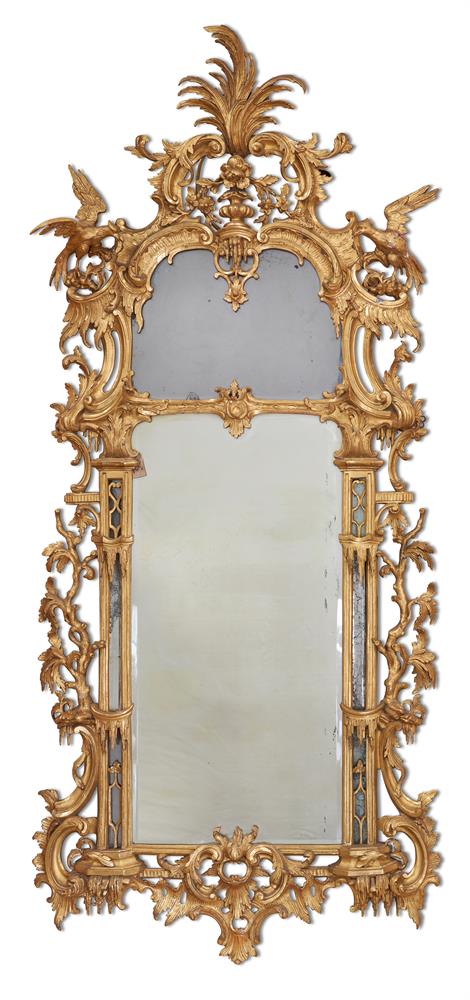A CARVED GILTWOOD MIRROR 18TH CENTURY AND LATER The architectural pediment and frame carved with a pierced shell, foliate scrolls and a trellis ground, the bevelled plate re-silvered and possibly original, the gilding revealing a yellow and red bole ground 274cm high, 142cm wide, 20cm deepProvenance:Gerald Tyrwhitt-Wilson, 14th Baron Berners (1883-1950), Faringdon House, Oxfordshire; and by descent from Lord Berners's companion Robert Heber-Percy toSofka Zinovieff (b. 1961), by whom sold; Christie's, London, 12 April 2018, lot 50, where described as George IV, with a subsequent saleroom notice analysing the two layers of gilding strataWith Jamb, London, (who undertook the removal of the late 19th century gilding by dry-stripping to reveal the 18th century gilding), where purchased by Robert Kime 2022. It is difficult to attribute the mirror to a particular carver / gilder, though it is likely that the maker was London-based, and probably well-established as the scale, complexity and quality suggests that it was probably part of a major commission for a large house from an established maker. The British and Irish Furniture Makers Online lists ten carvers and gilders active in London in the second quarter of the 18th century, any of whom may be candidates for the manufacture of this mirror: of the group, perhaps the most likely is William Walters or Waters (fl. 1732-42), who supplied giltwood furniture and mirrors for Benjamin Mildmay, Earl Fitzwalter at Moulsham Hall, Essex, for Charles Wyndham at Petworth House, and for the Earl of Leicester's London house; also to be considered is Henry Joris (fl. 1739), who worked with Paul Petit on the magnificent frame for Frederick the Great of Prussia; the other makers' reputations are less prominent, although Robert Johnson (fl. 1737-49) who was recorded at the Golden Head, Frith St, St Ann's, made frames for Petworth House; Charles Groves, fl. 1750, 'at the Golden Head, the further End of Brownlow Street from Drury Lane'; Robert Pulsford (fl. 1749), of Knightsbridge; Thomas King carver and gilder of Long Acre (his stock-in-trade sold in October 1742); Christopher Mason, carver and gilder of Charles Court (fl. 1749); Stephen Maren, carver and gilder of New Compton St, Soho (fl. 1749); Christopher Hammond, frame maker and gilder of Phoenix Court, Long Acre (fl. 1732); Godwin Prince, who advertised 'all sorts of cabinet & Upholsterers work in General, Likewise Carving & Gilding ... near Durham Yard, in the Strand' (fl. c. 1749) (British Museum, Heal 28.181).The rectangular 'tabernacle' design of mirror frame is derived from designs of the 1720s by the architect James Gibbs (1682-1754). These depend on overmantel designs by Inigo Jones which were published in Isaac Ware's Some Designs of Mr Inigo Jones and others (1731) - notably pl.31. Ware's book was highly influential in the development of English architecture and interiors in the 18th century. It brought together a collection of designs by two of the most important architects of the 17th and 18th centuries: Inigo Jones and William Kent Jones was a leading figure in the introduction of Italian Renaissance architecture to England, while Kent was a leading exponent of the Palladian style, as promoted by his patron, the influential Italophile Lord Burlington: many of the books' designs were taken from interior schemes devised by Kent at Burlington House.FOR THE FULL DESCRIPTON AND PROVENANCE, PLEASE CLICK HERE.SALEROOM NOTICE:The catalogue entry is now 'A CARVED GILTWOOD MIRROR, 18TH CENTURY AND LATER'
A CARVED GILTWOOD MIRROR 18TH CENTURY AND LATER The architectural pediment and frame carved with a pierced shell, foliate scrolls and a trellis ground, the bevelled plate re-silvered and possibly original, the gilding revealing a yellow and red bole ground 274cm high, 142cm wide, 20cm deepProvenance:Gerald Tyrwhitt-Wilson, 14th Baron Berners (1883-1950), Faringdon House, Oxfordshire; and by descent from Lord Berners's companion Robert Heber-Percy toSofka Zinovieff (b. 1961), by whom sold; Christie's, London, 12 April 2018, lot 50, where described as George IV, with a subsequent saleroom notice analysing the two layers of gilding strataWith Jamb, London, (who undertook the removal of the late 19th century gilding by dry-stripping to reveal the 18th century gilding), where purchased by Robert Kime 2022. It is difficult to attribute the mirror to a particular carver / gilder, though it is likely that the maker was London-based, and probably well-established as the scale, complexity and quality suggests that it was probably part of a major commission for a large house from an established maker. The British and Irish Furniture Makers Online lists ten carvers and gilders active in London in the second quarter of the 18th century, any of whom may be candidates for the manufacture of this mirror: of the group, perhaps the most likely is William Walters or Waters (fl. 1732-42), who supplied giltwood furniture and mirrors for Benjamin Mildmay, Earl Fitzwalter at Moulsham Hall, Essex, for Charles Wyndham at Petworth House, and for the Earl of Leicester's London house; also to be considered is Henry Joris (fl. 1739), who worked with Paul Petit on the magnificent frame for Frederick the Great of Prussia; the other makers' reputations are less prominent, although Robert Johnson (fl. 1737-49) who was recorded at the Golden Head, Frith St, St Ann's, made frames for Petworth House; Charles Groves, fl. 1750, 'at the Golden Head, the further End of Brownlow Street from Drury Lane'; Robert Pulsford (fl. 1749), of Knightsbridge; Thomas King carver and gilder of Long Acre (his stock-in-trade sold in October 1742); Christopher Mason, carver and gilder of Charles Court (fl. 1749); Stephen Maren, carver and gilder of New Compton St, Soho (fl. 1749); Christopher Hammond, frame maker and gilder of Phoenix Court, Long Acre (fl. 1732); Godwin Prince, who advertised 'all sorts of cabinet & Upholsterers work in General, Likewise Carving & Gilding ... near Durham Yard, in the Strand' (fl. c. 1749) (British Museum, Heal 28.181).The rectangular 'tabernacle' design of mirror frame is derived from designs of the 1720s by the architect James Gibbs (1682-1754). These depend on overmantel designs by Inigo Jones which were published in Isaac Ware's Some Designs of Mr Inigo Jones and others (1731) - notably pl.31. Ware's book was highly influential in the development of English architecture and interiors in the 18th century. It brought together a collection of designs by two of the most important architects of the 17th and 18th centuries: Inigo Jones and William Kent Jones was a leading figure in the introduction of Italian Renaissance architecture to England, while Kent was a leading exponent of the Palladian style, as promoted by his patron, the influential Italophile Lord Burlington: many of the books' designs were taken from interior schemes devised by Kent at Burlington House.FOR THE FULL DESCRIPTON AND PROVENANCE, PLEASE CLICK HERE.SALEROOM NOTICE:The catalogue entry is now 'A CARVED GILTWOOD MIRROR, 18TH CENTURY AND LATER'













.jpg)

Testen Sie LotSearch und seine Premium-Features 7 Tage - ohne Kosten!
Lassen Sie sich automatisch über neue Objekte in kommenden Auktionen benachrichtigen.
Suchauftrag anlegen